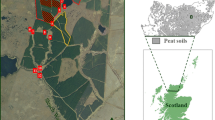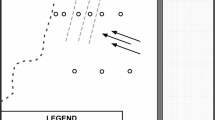Abstract
The effect of chronic high groundwater nitrate loading on riparian forests is poorly understood. The growth patterns of northern white cedar (Thuja occidentalis) and related plant–soil processes were examined at four riparian sites in southern Ontario, Canada which have similar vegetation, soils, and hydrology but have differed in adjacent land use for >60 years. Fertilized cropland at two riparian sites produced groundwater-fed surface flows with high mean NO3–N concentrations of 9 and 31 mg l−1, whereas mean concentrations were <0.5 mg l−1 at two control sites down slope from forest. Tree-ring analysis at the two nitrate-rich sites indicated a positive growth trend in 1980–2004 and an absence of a positive growth trend in the 1945–1970 period that preceded high rates of synthetic nitrogen fertilizer use on cropland. However, a significant increase in growth also occurred in 1980–2004 at the two control riparian sites suggesting that high groundwater nitrate inputs did not influence tree growth. Cedar foliar and litter N content did not differ significantly between the high nitrate and control sites. Litter decomposition rates measured by the litterbag technique at a nitrate-enriched and control site were similar. Litter from a high nitrate and a control site produced a similar rate of potential denitrification in lab incubations of riparian surface peat. This study indicates that prolonged nitrate inputs in groundwater did not increase nitrogen uptake and growth of white cedar or stimulate decomposition and denitrification as a result of changes in the quality of plant material. In the absence of anthropogenic nitrate inputs, riparian wetland soils are typically high in ammonium and low in nitrate, and as a consequence, white cedar may have a limited ability to utilize nitrate.





Similar content being viewed by others
References
Aber, J. D. (1992). Nitrogen cycling and nitrogen saturation in temperate forest ecosystems. Trends in Ecology & Evolution, 7, 220–223.
Aber, J. D., Nadelhoffer, K. J., Steudler, P., & Melillo, J. M. (1989). Nitrogen saturation in northern forest ecosystems. Bioscience, 39, 378–386.
Agriculture and Agri-Food Canada. (1998). Canadian Fertilizer consumption, shipments and trade. Winnipeg: AAFC.
Bowden, W. B. (1987). The biogeochemistry of nitrogen in freshwater wetlands. Biogeochemistry, 4, 313–349.
Cameron, S. G., & Schipper, L. A. (2010). Nitrate removal and hydraulic performance of organic carbon for use in denitrification beds. Ecological Engineering, 36, 1588–1595.
Devito, K. J., Fitzgerald, D., Hill, A. R., & Aravena, R. (2000). Nitrate dynamics in relation to lithology and hydrologic flow path in a river riparian zone. Journal of Environmental Quality, 29, 1075–1084.
Dillon, P. J., Lusis, M., Reid, B., & Yah, D. (1988). Ten-year trends in sulfate, nitrate and hydrogen deposition in Central Ontario. Atmospheric Environment, 2, 901–905.
Dodla, S. K., Wang, J. J., Delaune, R. D., & Cook, R. L. (2008). Denitrification potential and its relation to organic carbon quality in three coastal wetland soils. The Science of the Total Environment, 407, 471–480.
Downs, M. R., Nadelhoffer, K. J., Melillo, J. M., & Aber, J. D. (1993). Foliar and fine root nitrate reductase activity in seedlings of four forest tree species in relation to nitrogen availability. Trees, 7, 233–236.
Duchesne, L., Ouimet, R., & Houle, D. (2002). Basal area growth of sugar maple in relation to acid deposition, stand health and soil nutrients. Journal of Environmental Quality, 31, 1676–1683.
Eddy, W. C., Zak, D. R., Holmes, W. E., & Pregitzer, K. S. (2008). Chronic atmospheric NO −3 deposition does not induce NO −3 use by Acer saccharum Marsh. Ecosystems, 11, 469–477.
Ehrenfeld, J. G. (1987). The role of woody vegetation in preventing groundwater pollution by nitrogen from septic tank leachate. Water Research, 5, 605–614.
Fail, J. L., Hamzah, M. N., Haines, B. L., & Todd, R. L. (1986). Above and below ground biomass, production and element accumulation in riparian forests of an agricultural watershed. In D. L. Correll (Ed.), Watershed Research Perspectives (pp. 193–223). Washington, DC: Smithsonian.
Greenan, C. M., Moorman, T. B., Kaspar, T. C., Parkin, T. B., & Jaynes, D. B. (2006). Comparing carbon substrates for denitrification of subsurface drainage water. Journal of Environmental Quality, 35, 824–829.
Grissino-Mayer, H. D. (2001). Evaluating cross-dating accuracy: a manual and tutorial for the computer program COFECHA. Tree-Ring Research, 57, 205–221.
Groffman, P. M., Howard, G., Gold, A. J., & Nelson, W. M. (1992). Nitrate dynamics in riparian forests: microbial studies. Journal of Environmental Quality, 21, 666–671.
Hanson, G. C., Groffman, P. M., & Gold, A. J. (1994a). Denitrification in riparian wetlands receiving high and low groundwater nitrate inputs. Journal of Environmental Quality, 23, 917–922.
Hanson, G. C., Groffman, P. M., & Gold, A. J. (1994b). Symptoms of nitrogen saturation in a riparian wetland. Ecological Applications, 4, 750–756.
Hefting, M. M., Clement, J. C., Bienkowski, P., et al. (2005). The role of vegetation and litter in the nitrogen dynamics of riparian buffer zones in Europe. Ecological Engineering, 24, 465–482.
Hill, A. R. (1982). Nitrate distribution in the ground water of the Alliston region of Ontario, Canada. Ground Water, 20, 696–702.
Hill, A. R. (1983). Denitrification: its importance in a river draining an intensively cropped watershed. Agriculture, Ecosystems & Environment, 10, 47–62.
Hill, A. R. (1993). Nitrogen dynamics of storm runoff in the riparian zone of a forested watershed. Biogeochemistry, 20, 19–44.
Hill, A. R. (1996). Nitrate removal in stream riparian zones. Journal of Environmental Quality, 25, 743–755.
Hill, A. R., & Shackleton, M. (1989). Soil N mineralization and nitrification in relation to nitrogen solution chemistry in a small forested watershed. Biogeochemistry, 8, 167–184.
Hill, A. R., Devito, K. J., Campagnolo, S., & Sanmugadas, K. (2000). Subusrface denitrification in a forest riparian zone: interactions between hydrology and supplies of nitrate and organic carbon. Biogeochemistry, 51, 193–223.
Hofmeyer, P. V., Kenefic, L. S., & Seymour, R. S. (2009). Northern white cedar ecology and silviculture in the northeastern United states and southeastern Canada: A synthesis of knowledge. Northern journal of Applied Forestry, 26, 21–27.
Hornbeck, J. W., & Smith, R. B. (1985). Documentation of red spruce growth decline. Canadian Journal of Forest Research, 15, 1199–1201.
Johnson, W. F. (1990). Thuja occidentalis. In R. M. Burns & B. H. Honkala (Eds.), Silvics of North America Vol 1 (pp. 580–589). Washington, DC: USDA Forest Service.
Krajina, V. J., Madoc-Jones, S., & Mellor, B. (1973). Ammonium and nitrate in the nitrogen economy of some conifers growing in Douglas fir communities of the Pacific northwest of America. Soil Biology and Biochemistry, 5, 143–147.
Kronzucker, H. J., Siddiqi, M. Y., & Glass, A. D. M. (1997). Conifer root discrimination against soil nitrate and the ecology of forest succession. Nature, 385, 59–61.
LeBlanc, D. L. (1990). Relationships between breast-height and whole-stem growth indices for red spruce on Whiteface Mountain, New York. Canadian Journal of Forest Research, 20, 1399–1407.
LeBlanc, D. C., & Loehle, C. (1993). Effect of contaminated groundwater on tree growth: a tree-ring analysis. Environmental Monitoring and Assessment, 24, 205–218.
Matthes-Sears, U., & Larson, D. W. (1991). Growth and physiology of Thuja occidentalis L. from cliffs and swamps: is variation habitat or site specific? Botanical Gazette, 152, 500–508.
Mayer, P. M., Reynolds, S. K., McCutchen, M. D., & Canfield, T. J. (2007). Meta-Analysis of nitrogen removal in riparian buffers. Journal of Environmental Quality, 36, 1172–1180.
McFee, W. W., & Stone, E. L. (1968). Ammonium and nitrate as nitrogen sources for Pinus radiata and Picea glauca. Soil Science Society of America Journal, 32, 879–884.
Min, X., Siddiqi, M. Y., Guy, R. D., Glass, A. D. M., & Kronzucker, H. J. (1998). Induction of nitrate uptake and nitrate reductase activity in trembling aspen and lodgepole pine. Plant, Cell & Environment, 21, 1039–1046.
Nichols, D. S. (1983). Capacity of natural wetlands to remove nutrients from wastewater. Journal Water Pollution Control Federation, 55, 495–505.
Nihlgard, B. (1985). The ammonium hypothesis- an additional explanation to the forest decline in Europe. Ambio, 14, 2–8.
Phipps, R. L., & Whitton, J. C. (1988). Decline in long-term growth trends of white oak. Canadian Journal of Forest Research, 18, 24–32.
Ranalli, A. J., & Macalady, D. L. (2010). The importance of the riparian zone and in-stream processes in nitrate attenuation in undisturbed and agricultural watersheds- A review of the scientific literature. Journal of Hydrology, 389, 406–415.
Roulet, N. T. (1990). Hydrology of a headwater basin wetland: groundwater discharge and wetland maintenance. Hydrological Processes, 4, 387–400.
Schade, J. D., & Lewis, D. B. (2006). Plasticity in resource allocation and nitrogen-use efficiency in riparian vegetation; implications for nitrogen retention. Ecosystems, 9, 740–755.
Schindler, D. W., Dillon, P. J., & Schreier, H. (2006). A review of anthropogenic sources of nitrogen and their effects on Canadian aquatic ecosystems. Biogeochemistry, 79, 25–44.
Shabaga, J. A., & Hill, A. R. (2010). Groundwater-fed surface flow path hydrodynamics and nitrate removal in three riparian zones in southern Ontario, Canada. Journal of Hydrology, 388, 52–64.
Stokes, M. A., & Smiley, T. L. (1968). An introduction to tree-ring dating. Chicago: University of Chicago Press.
Summers, P. W., & Whelpdale, D. M. (1976). Acid precipitation in Canada. Water, Air, and Soil Pollution, 6, 447–455.
Technicon Industrial Systems. (1977). Nitrate and nitrite in water and seawater. Tarrytown: Technicon Industrial Systems. Industrial Method 158–71 WIA.
Templar, P. H., & Dawson, T. E. (2004). Nitrogen uptake by four tree species of the Catskill Mountains, New York: implications for forest dynamics. Plant and Soil, 262, 251–261.
Thomas, R. Q., Canham, C. D., Weathers, K. C., & Goodale, C. L. (2010). Increased tree carbon storage in response to nitrogen deposition in the US. Nature Geoscience, 3, 13–17.
Vidon, P., & Hill, A. R. (2004a). Landscape controls on the hydrology of stream riparian zones. Journal of Hydrology, 292, 210–228.
Vidon, P., & Hill, A. R. (2004b). Landscape controls on nitrate removal in stream riparian zones. Water Resources Research, 40, W03201. doi:10.1029/2003WR002473.
Vidon, P., & Hill, A. R. (2004c). Denitrification and patterns of electron donors and acceptors in eight riparian zones with contrasting hydrogeology. Biogeochemistry, 71, 259–283.
Vitousek, P. M., Aber, J. D., Howarth, R. W., et al. (1997). Human alteration of the global nitrogen cycle: sources and consequences. Ecological Applications, 7, 737–750.
Warwick, J., & Hill, A. R. (1988). Nitrate depletion in the riparian zone of a small woodland stream. Hydrobiologia, 157, 231–240.
Yanosky, T. M., Hansen, B. P., & Schening, M. R. (2001). Use of tree rings to investigate the onset of contamination of a shallow aquifer by chlorinated hydrocarbons. Journal of Contaminant Hydrology, 50, 159–173.
Yoshinari, T., & Knowles, R. (1976). Acetylene inhibition of nitrous oxide reduction by denitrifying bacteria. Biochemical and Biophysical Research Communications, 69, 705–710.
Zhu, W. X., & Ehrenfeld, J. G. (1999). Nitrogen mineralization and nitrification in suburban and undeveloped Atlantic white cedar wetlands. Journal of Environmental Quality, 28, 523–529.
Acknowledgements
We thank Mark Blackwell, Luciella Longo, Agnieska Groszkowska, and Daniel Ferreira for their assistance in the field and Jackson Langat for lab assistance. Thanks are also due to Carolyn King in the York Geography Department cartographic office for the figures. We are grateful to two anonymous reviewers for their helpful comments on the manuscript. The research was supported by grants from the National Sciences and Engineering Research Council of Canada to A. R. Hill.
Author information
Authors and Affiliations
Corresponding author
Rights and permissions
About this article
Cite this article
Bravo, D., Hill, A.R. The Effect of Chronic High Groundwater Nitrate Loading on Riparian Forest Growth and Plant–Soil Processes. Water Air Soil Pollut 223, 73–84 (2012). https://doi.org/10.1007/s11270-011-0840-7
Received:
Accepted:
Published:
Issue Date:
DOI: https://doi.org/10.1007/s11270-011-0840-7




